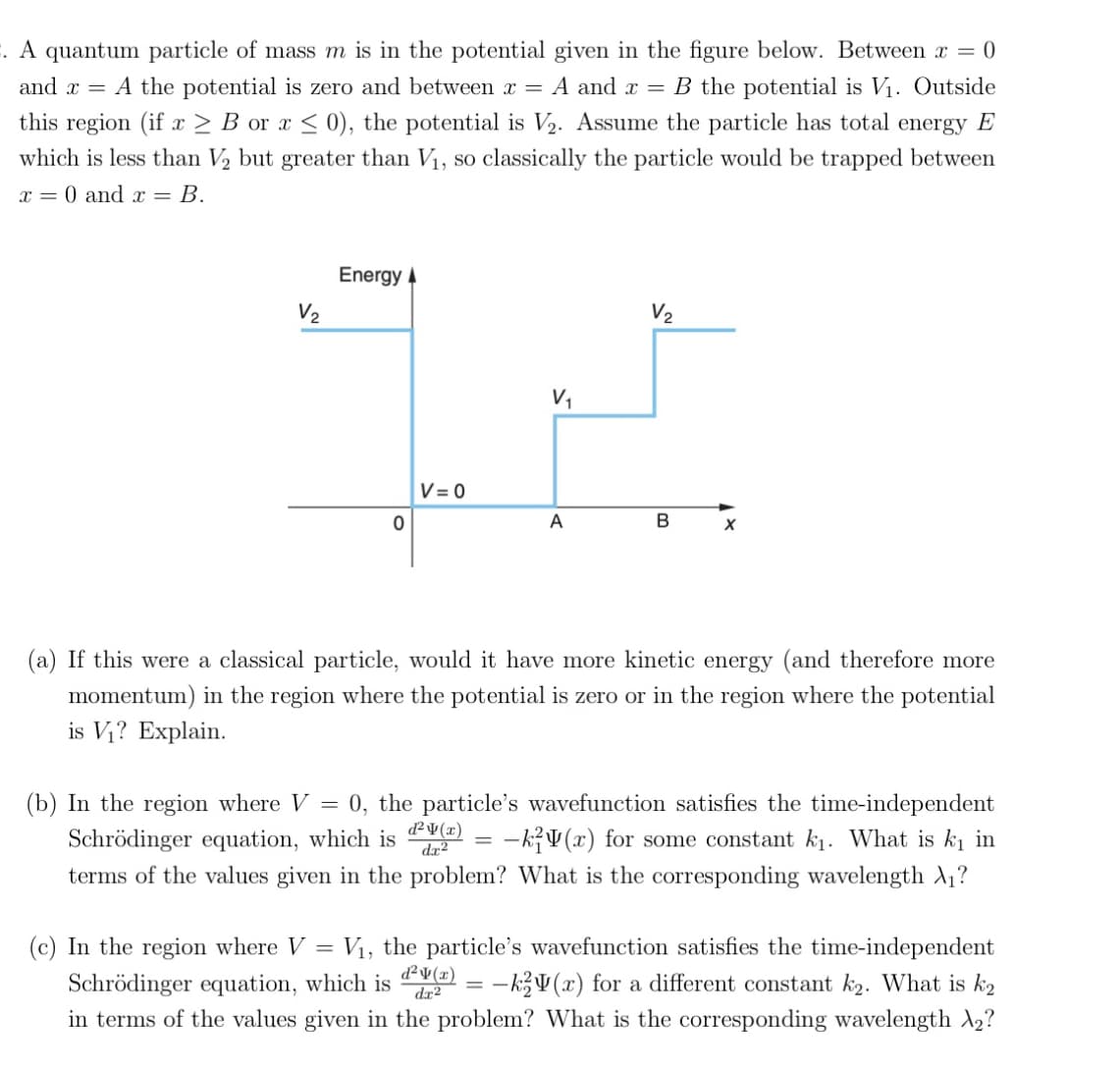. A quantum particle of mass m is in the potential given in the figure below. Between x = 0 and x = A the potential is zero and between x = A and x = B the potential is V₁. Outside this region (if x ≥ B or x ≤ 0), the potential is V2. Assume the particle has total energy E which is less than V₂ but greater than V₁, so classically the particle would be trapped between x = 0 and x = B. Energy A V₂ IN V₁ V=0 0 A V₂ B X (a) If this were a classical particle, would it have more kinetic energy (and therefore more momentum) in the region where the potential is zero or in the region where the potential is V₁? Explain. = (b) In the region where V = 0, the particle's wavefunction satisfies the time-independent Schrödinger equation, which is ²2(2) -ky(x) for some constant k₁. What is k₁ in terms of the values given in the problem? What is the corresponding wavelength A₁? d.x² (c) In the region where V = V₁, the particle's wavefunction satisfies the time-independent d²v(x) Schrödinger equation, which is -k(x) for a different constant k₂. What is k₂ dx² in terms of the values given in the problem? What is the corresponding wavelength λ₂?
. A quantum particle of mass m is in the potential given in the figure below. Between x = 0 and x = A the potential is zero and between x = A and x = B the potential is V₁. Outside this region (if x ≥ B or x ≤ 0), the potential is V2. Assume the particle has total energy E which is less than V₂ but greater than V₁, so classically the particle would be trapped between x = 0 and x = B. Energy A V₂ IN V₁ V=0 0 A V₂ B X (a) If this were a classical particle, would it have more kinetic energy (and therefore more momentum) in the region where the potential is zero or in the region where the potential is V₁? Explain. = (b) In the region where V = 0, the particle's wavefunction satisfies the time-independent Schrödinger equation, which is ²2(2) -ky(x) for some constant k₁. What is k₁ in terms of the values given in the problem? What is the corresponding wavelength A₁? d.x² (c) In the region where V = V₁, the particle's wavefunction satisfies the time-independent d²v(x) Schrödinger equation, which is -k(x) for a different constant k₂. What is k₂ dx² in terms of the values given in the problem? What is the corresponding wavelength λ₂?
Related questions
Question
Please answer !!

Transcribed Image Text:. A quantum particle of mass m is in the potential given in the figure below. Between x = 0
and x = A the potential is zero and between x = A and x = B the potential is V₁. Outside
this region (if x ≥ B or x ≤ 0), the potential is V₂. Assume the particle has total energy E
which is less than V₂ but greater than V₁, so classically the particle would be trapped between
x = 0 and x = B.
V₂
Energy A
0
V=0
V₁
A
=
V₂
B
X
(a) If this were a classical particle, would it have more kinetic energy (and therefore more
momentum) in the region where the potential is zero or in the region where the potential
is V₁? Explain.
(b) In the region where V = 0, the particle's wavefunction satisfies the time-independent
Schrödinger equation, which is ²2(2)
-ky(x) for some constant k₁. What is k₁ in
terms of the values given in the problem? What is the corresponding wavelength A₁?
dx²
(c) In the region where V = V₁, the particle's wavefunction satisfies the time-independent
d²v(x)
Schrödinger equation, which is
-k(x) for a different constant k₂. What is k₂
dx²
in terms of the values given in the problem? What is the corresponding wavelength ₂?
Expert Solution
This question has been solved!
Explore an expertly crafted, step-by-step solution for a thorough understanding of key concepts.
Step by step
Solved in 2 steps with 2 images
